Originally released back in 2004 Santorini was a pretty popular abstract strategy game even if it wasn’t much to look at as it mostly utilized pretty basic components. While it had a strong following it never really made it into the mainstream. That changed in 2016 when a new version of the game was released. For the most part the 2016 version is the same as the original game outside of a couple slight rule changes and significantly better component quality. While I am not the biggest fan of abstract strategy games I wanted to eventually try out Santorini as I have heard many good things about the game. Being ranked near the top 100 board games of all time is a hard thing to accomplish after all. I don’t think Santorini lives up to all of the hype surrounding the game, but it is still one of the best abstract strategy games that I have ever played.
How to Play Santorini
Setup
- Insert the gameboard on top of the cliff pedestal and place it in the middle of the table.
- Each player chooses a color and takes both pawns/builders of their chosen color.
- The youngest player will start the game. They will place their two builders on two unoccupied spaces on the gameboard. The other player(s) will then take turns placing their pieces on the board.
As players are familiarizing themselves with the game it is recommended that you play the basic game. Once you are familiar with the game it is recommended that you use both the basic and advanced rules.
Playing the Basic Game
Each player will start their turn by choosing one of their builders. They will then take two actions (both actions are mandatory). After they take both actions play will pass to the next player
Moving
A player begins their turn by moving one of their builders. Builders can be moved to one of the eight neighboring spaces on the board. There are only two rules regarding movement. First you cannot move a builder onto a space already occupied by another builder or a dome. The other rule is that builders can only move up one level each time they move. For example they can move from the ground level to a first level or from a first level to a second level. Builders can jump down any number of levels when moving.
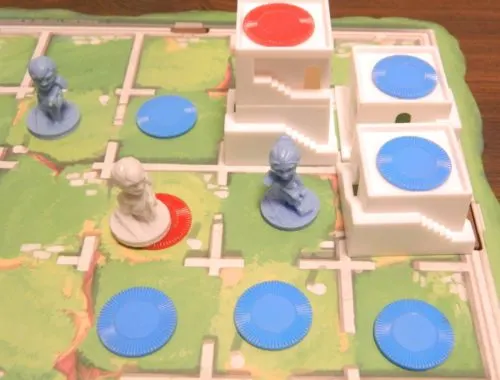
The grey piece in the middle of the picture is about to move. The builder can move to any of the spaces which feature a blue chip. The builder can’t move to the space to their left because there is another builder on the space. The builder can’t move to the space behind them as that space is two levels higher than their current position.
Builder
After a player moves their builder they will have to build. The player will add the next level or a dome to one of the eight adjacent spaces to the builder that was moved. The space they build on cannot be occupied by another worker. You can build on any level even if it is higher than the builder’s current position.
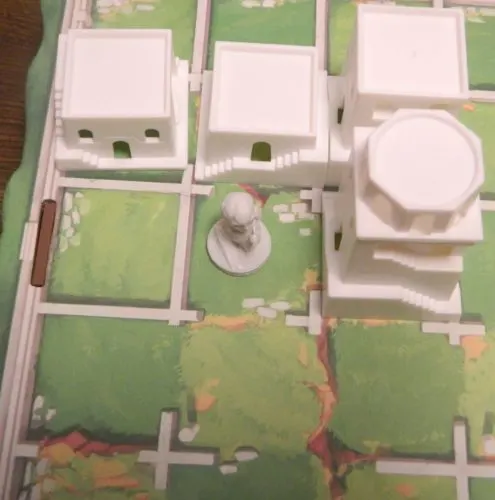
This builder is about to build. They can place a level one building on the three spaces below them or the space left of them. They will place a level two building on the space above them and the space above and to the left. The space above and to the right will use a level three piece. Finally the space to the right will use a dome.
When placing building pieces you will use the level piece corresponding to the level you are building.
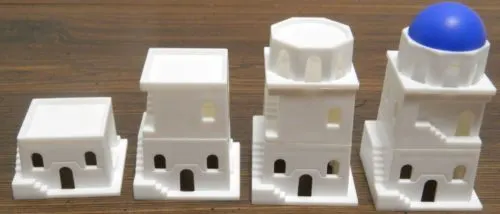
Starting from the left is a level one building. The second building is a level two building and so on. The building on the right has a dome on top of it.
Once the third level is built a player can place a dome on top of the tower. Once a dome has been placed the tower is complete and no builder can move onto the space for the rest of the game.
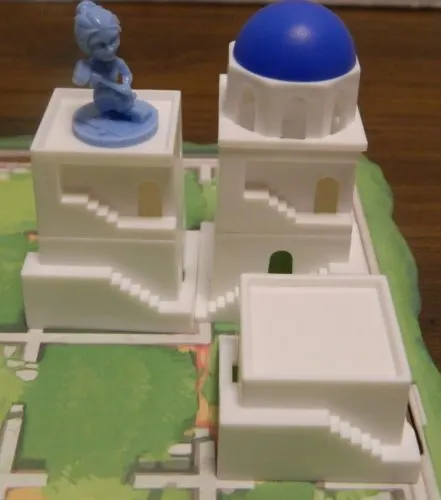
A dome was played on the space to the right of the builder. Players can no longer move onto this space.
Winning the Game
There are two ways to win Santorini.
If a player moves one of their workers onto the third level of a tower the player automatically wins the game.
If one of the players cannot perform both the move and build action on their turn they are eliminated from the game. If only one player remains they will win the game.
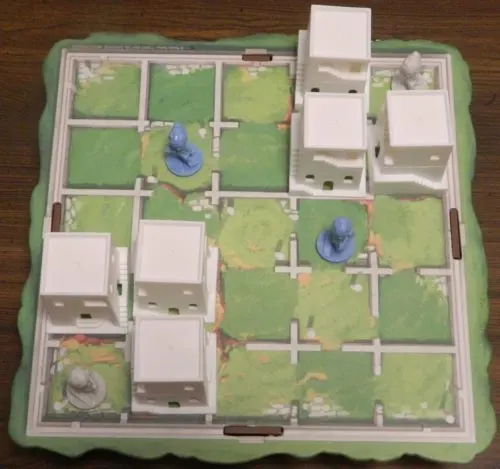
The two grey pieces have been blocked in where they cannot move on their next turn. The other player has won the game.
Playing the Advanced Game
The advanced game mostly differs from the basic game because it adds in God Powers. The players choose who will be the Challenger which is the player that is the most “god-like”. The Challenger draws a number of God Powers cards equal to the number of players. In three and four player games not all of the God Powers cards are playable. If you are playing with three or four players any cards that don’t feature the three or four player symbols are discarded and you will draw new God Powers cards. Starting to the left of the Challenger each player chooses which God Powers card they would like to use during the game. After everyone has a God Powers card the Challenger will choose who will start the game. The chosen player will place their builders followed by the player to their left and so on until all of the builders are placed.
Most of the gameplay in the advanced game is the same as the basic game except for some additions due to the God Powers cards that players control. Each God Powers card gives the player a special ability that they can use throughout the game. Most of these God Powers either give you additional movement or building powers. Some add additional winning conditions to the game though. If the player who controls one of these God Powers meets the winning conditions from the card they will automatically win the game.
God Powers
This is a brief explanation of each of the God Powers.
#1 Apollo – You may move your worker onto a space occupied by an opponent’s builder. Their builder will be moved to the space your builder was just on.
#2 Artemis – You may move your builders two spaces but you may not move back to the space you started your turn on.
#3 Athena – If you moved one of your workers up one level on your previous turn, your opponent may not move up a level on their turn.
#4 Atlas – Your builders can build a dome on any level including the ground.
#5 Demeter – Your builders can build twice on your turn, but may not build twice on the same space.
#6 Hephaestus – Your builders can build twice on the same space. They may not use this ability to place a dome though.
#7 Hermes – If your builders don’t change their level they may move as many spaces as they want (including staying on their current space). You can then build based on the position of either of your builders.
#8 Minotaur – You may move your builder onto a space occupied by an opponent’s builder if the next space in the same direction is unoccupied. You will push the other player’s builder into the next space in the same direction.
#9 Pan – If one of your builders moves down two spaces in one movement you will automatically win the game.
#10 Prometheus – If you don’t move up a level during your turn you may build before and after you move.
#11 Aphrodite – When an opponent’s builder starts their turn on a neighboring space to one of your builders they must end their turn on a space next to one of your builders.
#12 Ares -You may remove any unoccupied block (not a dome) on a space neighboring one of your builders before you move them.
#13 Biq – During setup you get to place your builders first and they must be placed on perimeter spaces. During the game if you move one of your builders onto a space and the next space in the same direction is an opponent’s builder, that builder is removed from the game.
#14 Chaos – Shuffle all of the simple God Powers cards (#1-10) that haven’t been claimed by one of the other players. These cards will form a draw deck for the Chaos player. Throughout the game you will have the power of the top card from the simple God Powers deck. Each turn that a player completes a tower with a dome you will draw the next card from the deck which replaces your previous power. If you ever run out of cards reshuffle the deck and start again.
#15 Charon – Before you move a builder if there is an opponent builder on a neighboring space you can move it to the other side of your builder if the space is unoccupied.
#16 Chronus – You will immediately win the game if there are five complete towers on the board.
#17 Circe – If the other players’ builders are not on adjacent spaces, you are the only player that can take advantage of their God Powers card.
#18 Dionysus – Each time you complete a tower with a dome you can take another turn. With this turn you will move and build with one of the other player’s builders. No one can win the game during this turn.
#19 Eros – During setup you will place your builders on opposite sides of the gameboard. If you can ever move both of your builders to adjacent spaces that are both level one you will automatically win the game. For three player games the builders just have to be on the same level.
#20 Hera – A player cannot win by moving to a perimeter space.
#21 Hestia – You can build twice on your turn. Neither building can be placed on a perimeter space though.
#22 Hypnus – If an opponent’s builder is on a higher level than their other builder they cannot move their higher up builder.
#23 Limus – Opponents’ builders cannot build on a space adjacent to one of your workers except for domes.
#24 Medusa – If any opponents’ builders are on an adjacent space to one of your builders and they are on a lower level, their builders are eliminated from the game. Their builder is replaced with the corresponding level of building.
#25 Morpheus – At the beginning of each turn you will place either a level or a dome on your God Powers card. When building you can build as many of the blocks from your God Powers as you want (including zero). At any time the other player(s) can exchange one of the blocks from the God Powers card with another from the supply.
#26 Persephone – On an opponent’s turn if they can move up a level they must move up one level.
#27 Poseidon – If the builder you don’t move is on the ground they may build up to three times on neighboring spaces.
#28 Selene – During setup you will use a male and female builder. During the game you may build a dome on any level with your female builder even if you moved your male mover.
#29 Triton – Whenever one of your builders moves onto a perimeter space they can immediately move again.
#30 Zeus – You may build on the space underneath the builder you moved thus raising your builder up one level. You cannot win by raising your builder to the third level in this way.
My Thoughts on Santorini
Heading into Santorini I didn’t know exactly what to expect. The game has received a lot of praise. At the same time I have never been a huge fan of abstract strategy games. There is just something about abstract strategy games where I have never liked them as much as other genres. I am a fan of strategy in board games, but for some reason I have never been a fan of the type of strategy that you find in abstract strategy games. I usually find abstract strategy games to be kind of dull as they require too much thought and not enough payoff. With all that said I enjoyed playing Santorini even though I still think it is a little overrated.
At its core Santorini is a really simple game. In the basic game you take two actions each turn. You move one of your pieces and then add a level to a neighboring space. You use these two actions to try to get one or your pieces onto a third level building or prevent the other player(s) from performing one of the actions on their turn. That sums up the entire basic game. I have to admit that I was actually really surprised by how simple Santorini is as I was expecting a significantly more complicated board game. The game only has a recommended age of 8+ and that seems fair even though I think younger children could play the game with a little help.
This simplicity also leads to the game playing quite quickly. The length of the game will somewhat depend on the number of players. The factor that will have a bigger impact though is how much the players suffer from analysis paralysis. If players don’t take too long to make a decision the game should move along pretty quickly unless players keep messing with each other’s plans. If players need to thoroughly analyze each potential move though the game could take quite a bit longer. In general I would say that most games should only take around 10-20 minutes. This short length is a benefit to the game in my opinion as it lets you finish games quickly while allowing for a rematch afterwards if the players want one.
While playing Santorini I kept having flashbacks to another board game that I took a look at a while ago. That game was Strata 5. Santorini reminded me a lot of Strata 5 because the two games actually share a lot in common. In both games you basically take the same actions each turn as you move a piece(s) and then add a block to the gameboard. The movement options are slightly different and the blocks are different shapes, but otherwise the two games are very similar. You even win in the same way in both games. You can win by either preventing your opponent from moving or you can have one of your pieces reach a certain level.
When I reviewed Strata 5 I found it to be a really frustrating game. There was a lot that I really liked about Strata 5 as it showed a lot of potential. Unfortunately due to some issues the game never fulfilled its potential and ended up as a disappointment. This is where Santorini comes into play as it shares a lot in common with Strata 5. I am not sure if Santorini’s developer (Gordon Hamilton) took inspiration from Strata 5 or if it was just a coincidence. The good news is that where Strata 5 failed to capitalize on the potential, Santorini succeeds into taking advantage of the interesting mechanics while eliminating many of the issues with Strata 5.
The most prominent change is that Santorini reduced the size of the gameboard. This adds a lot more player interaction to the game which is something that was a big problem with Strata 5. Unlike Strata 5 you can’t just build your own little tower and ignore the other player. This strategy would only work if one player is totally clueless and allows you to win without putting up a fight. More likely you and your opponent will build off the same set of towers as you build your own path to a level three tower. The game adds a few other mechanics that just make it a more enjoyable game than Strata 5. After playing Santorini I see no reason to own a copy of Strata 5 as Santorini is clearly the superior game.
For the most part I liked Santorini’s basic gameplay. The gameplay does a great job finding a good balance between simplicity and strategy. The gameplay is quite simple as you only have to make two simple decisions each turn. The game has a decent amount of strategy as well. There is a limit on what you can do on your turn (which is a good thing as it limits analysis paralysis), but you still have quite a big impact on your fate. Most of the gameplay revolves around coming up with a plan to get one of your pieces up to a third level that the other player won’t notice. At the same time you need to prevent your opponent from doing the same.
The problem with the basic gameplay is that it has most of the same issues that I have with most abstract strategy games. The gameplay is interesting and provides a lot of options. It can get a little repetitive after a while though. Every turn you do the exact same things. You are basically hoping to outsmart or trick your opponent in order to win the game. After a while this can become a little dull. I could see playing two or three games at a time, but then get a little sick of Santorini and put it away for a while. This is probably the main reason why I think Santorini is a little overrated. Santorini is still probably one of the best abstract strategy games that I have ever played, but the gameplay doesn’t reach the level of other genres that I prefer more than abstract strategy games.
So far I have only talked about the basic game but there is more to Santorini. Once you are familiar with the basic mechanics you can move onto using the advanced mechanics. This mostly involves the addition of the God Powers cards. There are a lot of things that I like about the God Powers cards but there is one somewhat significant issue as well.
The God Powers cards are mostly used to add some variety to the game. Each player gets one card which will give them a special ability in the game. Most of these involve how you can move your own builders, how you can build, or they might add some additional winning conditions. These cards can really change up the gameplay as they make each game feel unique. The basics remain the same, but the special abilities give you different strategies that you can pursue. You need to adapt your normal strategy based on which power you and the other player(s) has. Some of these powers can add some really interesting twists to the gameplay which should help the game remain interesting for longer. They could also add some interesting new strategies to the game.
At the same time the God Powers cards can add a decent amount of luck to Santorini. Instead of a game that relies entirely on your strategy, the god matchup will have an impact on the outcome. This mostly comes from all of the gods not being created equal. Each god’s power is interesting as it gives you something that can make it easier to win the game. Some gods are considerably more powerful than others though. Some god abilities will give you a slight edge while others can be gamebreaking. It is not always that one god is better than another either. Some gods just have a huge advantage over other gods. In these cases their abilities mostly neutralize the other god’s ability while still providing an additional benefit to their player. This adds a lot of luck to the game since if you get into a bad matchup you are going to have a hard time winning unless you have a considerably better strategy than your opponent.
As the God Powers cards add both some positives and negatives to the game it is kind of hard to figure out what you should do with them. If you want a game that relies purely on strategy with no luck whatsoever I would recommend just playing the basic game as the outcome should rely entirely on what player is able to outsmart the other player. This will get dull after a while though so I ultimately would recommend using the God Powers cards. I would consider taking some of the most powerful cards out of the game though and only use them when the other player also has a powerful god. I would also recommend drawing new cards if you get one of the matchups where one god has a significant advantage over the other god as the game will probably be pretty boring as one player will have an unfair advantage.
In theory Santorini supports up to four players. While I didn’t play the game with more than two players I probably wouldn’t recommend it. Even the game itself recommends playing with only two players. This is mostly because just like with most abstract strategy games it just works better with two players. The four player game forces players to play in teams. The only difference this has on the game is that teammates have to take turns and can only use their own god card. This doesn’t feel like it would add enough to the game to offset having to wait around for other players. I think the worst game though would be the three player game. The problem with the three player game is that it has the potential to create a kingmaker. Two players could directly or indirectly gang up on the third player putting them at a pretty significant disadvantage. Unless you have no other options I would highly recommend playing Santorini two player.
Before wrapping up I want to quickly talk about Santorini’s component quality. One of the biggest differences between the 2016 and 2004 versions of the game is the quality of the components. There really is no comparison between the components of the two versions as the new version is significantly better. For the most part I really liked the components in the 2016 version of Santorini. The various level blocks show quite a bit of detail which is not necessary for the gameplay, but it adds quite a bit to the game’s theme. I kind of wish the pieces had some color though. I also loved the game’s artwork. The art style is kind of cartoony but I really liked it as it brings a lot of character to the game. The game also includes 30 different god cards which adds a lot of variety to the game as you will only use two to four each game. You will have to play quite a few games before you get a rematch. If that is not enough you can also pick up the expansion pack the Golden Fleece which adds even more god cards to the game. While the game could have just stuck with the basic components from the 2004 version, I am really glad that the game decided to upgrade the components for the 2016 version.
Should You Buy Santorini?
Santorini has received a lot of praise in recent years and I was intrigued to see if the game was worthy of its reputation. In a lot of ways it is but it is still a little overrated. At its core Santorini is a really simple game that plays quickly. The basic gameplay involves just moving one of your pieces and then adding a level to an adjacent space. This is really simple and yet there is quite a bit of strategy hidden beneath the surface. Santorini has a good balance between simplicity and strategy as almost everyone can play it and yet the game still mostly relies on strategy over luck. Like with a lot of abstract strategy games though the gameplay can become a little dull after a while. This leads to the advanced game where God Powers are added which mix things up. I like the God Powers as they add a lot of variety to the game breathing a lot of life into the game. They also add a lot of luck to Santorini though as they aren’t always particularly balanced. Ultimately this leads to a fun experience that can rely a little too much on luck at times. All of this is topped off with components that are considerably better than I was expecting.
My recommendation for Santorini mostly comes down to your feelings on the premise and abstract strategy games in general. If the premise doesn’t really interest you or you hate abstract strategy games Santorini is not going to be for you. If you have mixed feeling about abstract strategy games (like me), you should have some fun with Santorini as it is one of the best games from the genre that I have ever played. People who love abstract strategy games though should love Santorini and I would highly recommend that they check it out.
Buy Santorini online: Amazon (Base Game), Amazon (Expansion)
, eBay

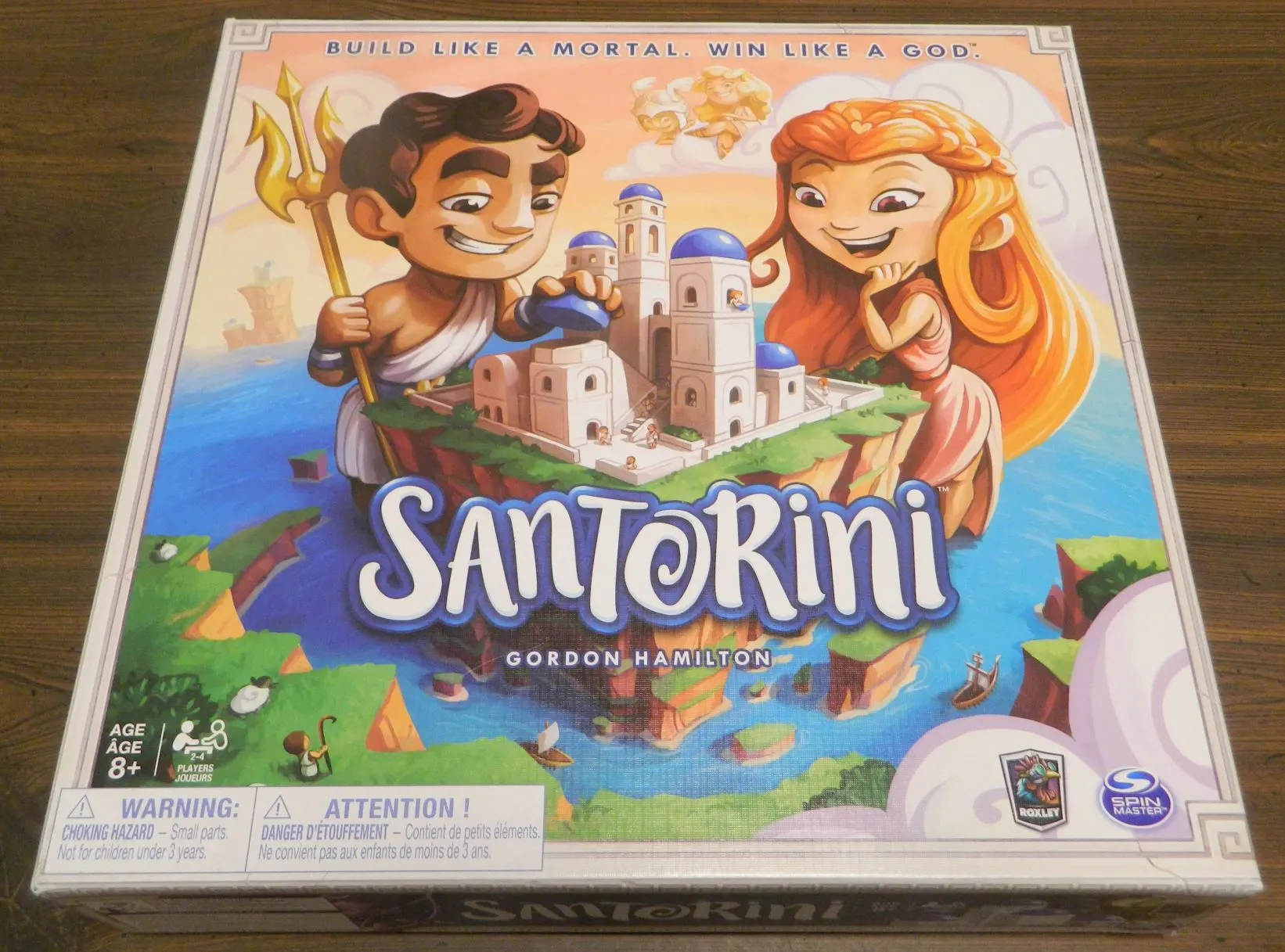
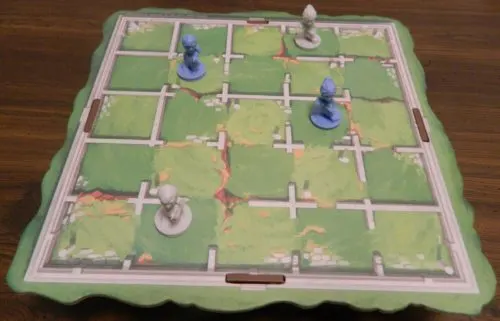
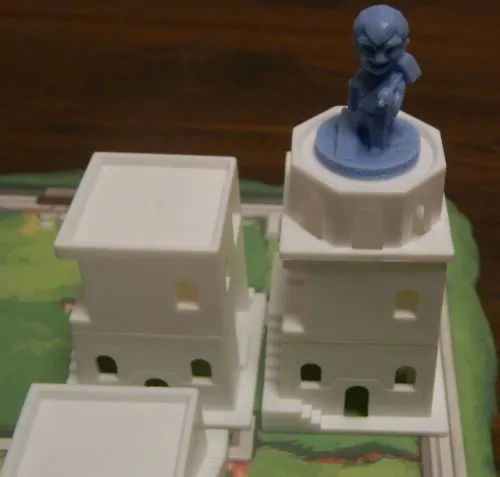
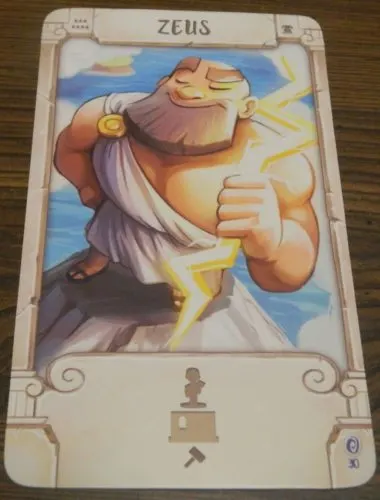
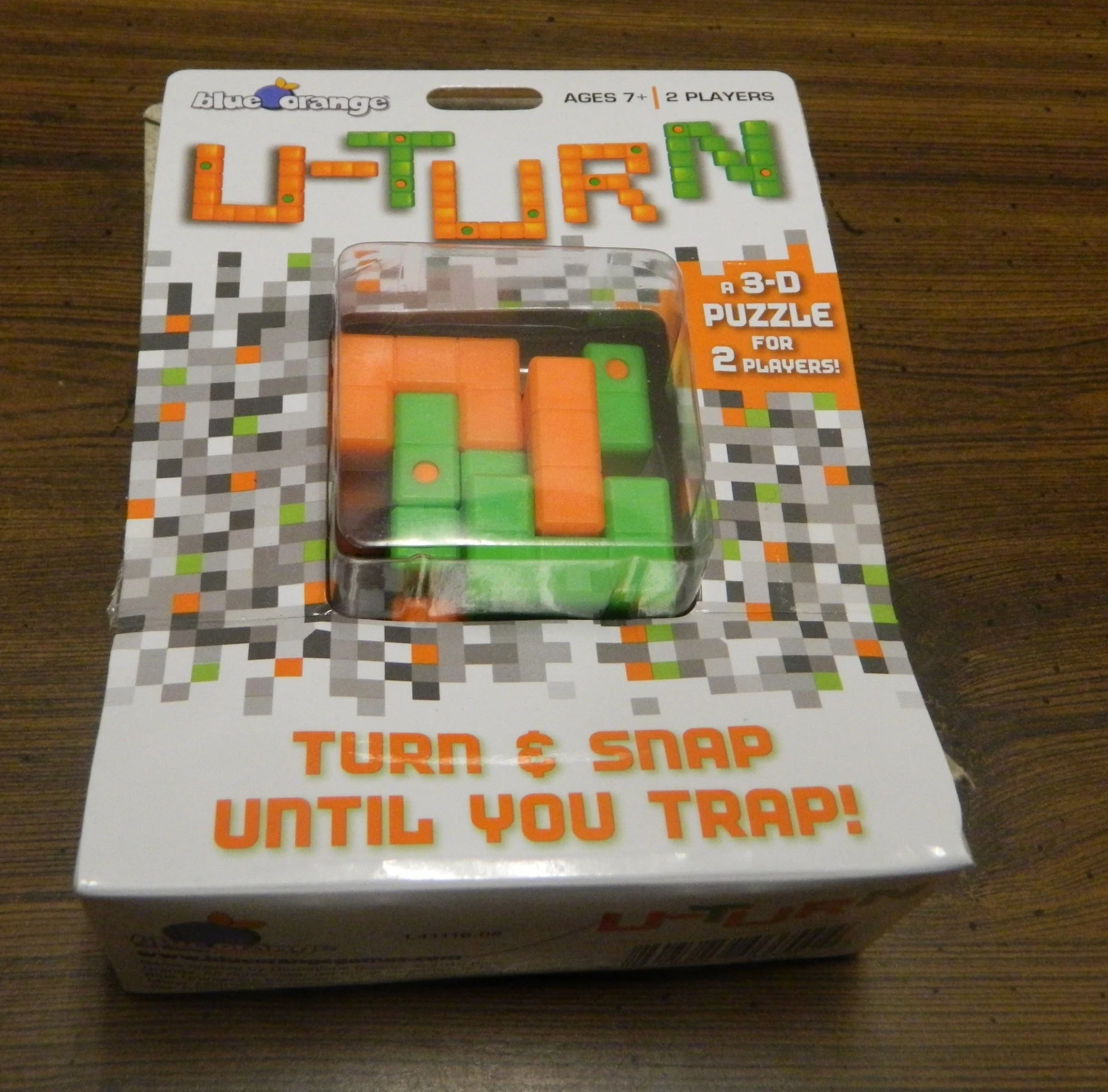
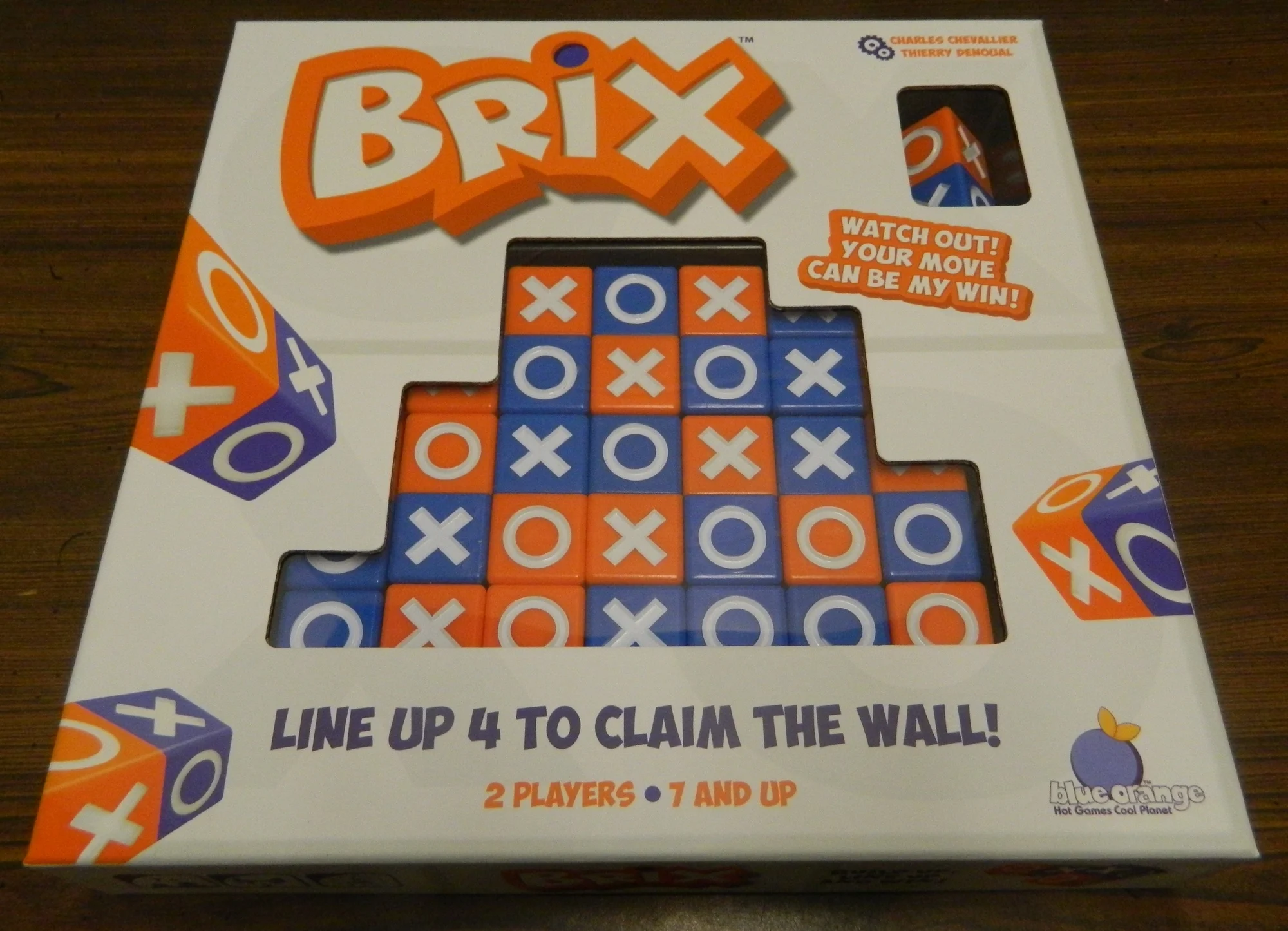
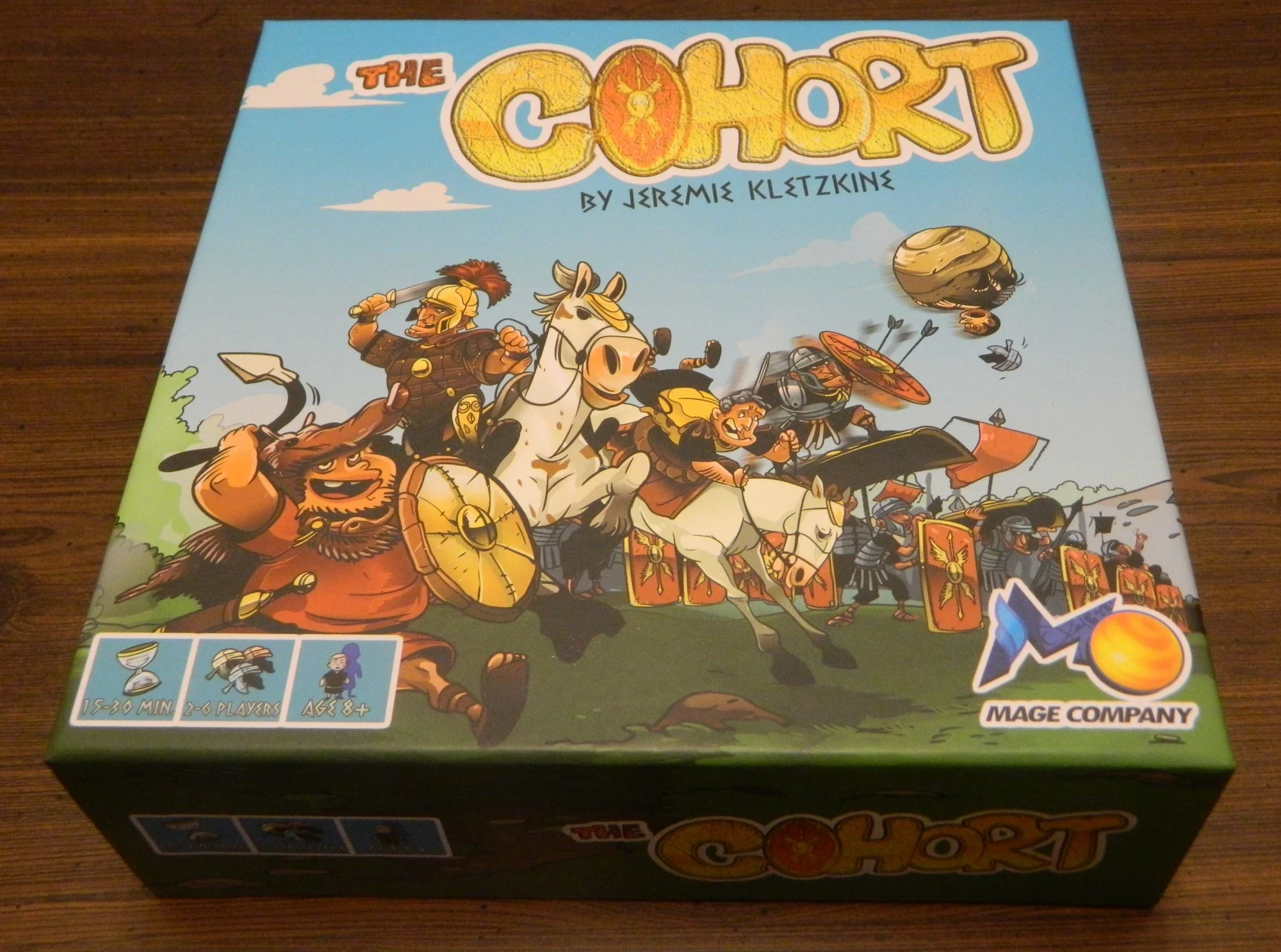

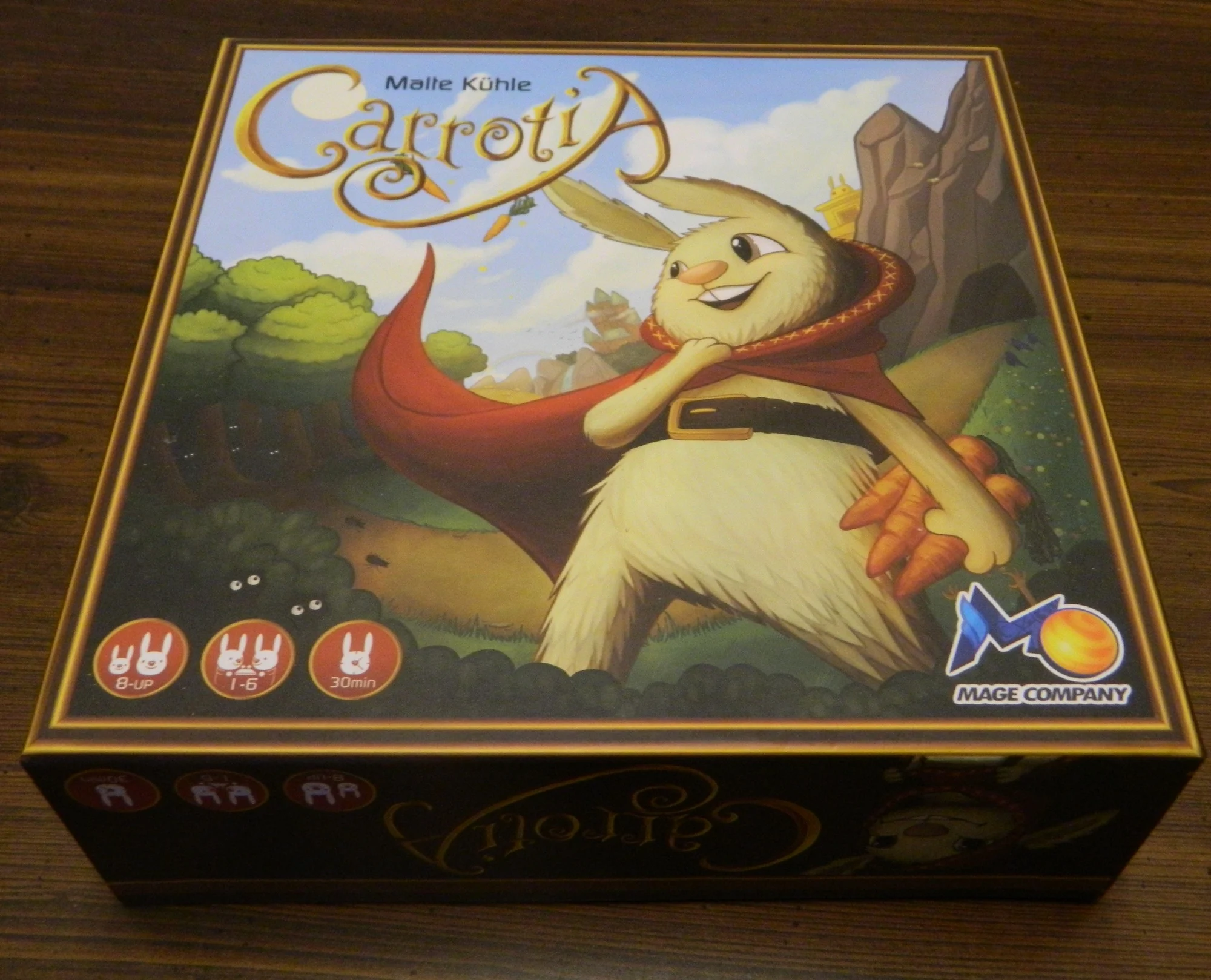
Jennifer Mathena
Wednesday 1st of January 2020
Hi! We were getting ready to use the God Cards for Santorini and the instructions are really unclear. Can you explain in detail how to deal out the cards? Much appreciated! ~ Jennifer
Eric Mortensen
Thursday 2nd of January 2020
For the god cards you randomly draw a number of cards equal to the number of players. If you are playing with three or four players you may have to draw new cards to replace any cards that are not allowed in three or four player games (there will be a symbol on the card to indicate this). You will then determine who is the "challenger". The official rules say this should be the player that is most "god-like", but you can use whatever criteria you want. Starting with the player to the left of the challenger each player will choose one of the remaining god cards (the cards that were randomly drawn) that they would like to use. This continues until the challenger takes the last remaining card. The challenger will then decide which player will start the game.
If you have any other questions feel free to leave another comment.